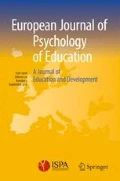Abstract
The paper deals with the problems of students’ everyday conceptions of the day/night cycle and seasonal changes and the influence of teaching on these conceptions. Students of regular state schools and an alternative Waldorf school were compared. Textbook analysis was carried out and 276 schoolchildren from grades 3–9 were questioned in written form. Children’s explanations and illustrations were analyzed and compared with those found in the textbooks. The results showed that students need much more guidance in learning contemporary explanations of astronomical phenomena in school. It was shown that textbooks used in regular schools provide confusing and misleading information that is misinterpreted by children. It was shown that regular school students relied for their answers more on verbal facts taught in school, but Waldorf school students gave more simple descriptive answers.
Résumé
La recherche traite les problèmes de la conception que les élèves ont en apprenant le cycle jour/nuit et les changements de saisons; il traite aussi de l’influence de l’enseignement sur leur conception. Les élèves des écoles d’Etat ordinaires et d’une école Waldorf furent comparées. Une analyse de manuels fut réalisée et 276 élèves des classes 3–9 furent questionnés à l’écrit. Les explications et les exemples donnés par les élèves furent analysés et comparés avec ceux des manuels. Il en résulte que les élèves ont besoin de plus de direction en apprenant les notions des phénomènes astronomiques. Il résulte aussi que les manuels utilisés dans les écoles ordinaires provoquent chez les élèves la confusion et l’incompréhension. Les élèves des écoles ordinaires se basent en répondant sur les faits verbaux enseignés à l’école mais les élèves de l’école Waldorf donnent des réponses descriptives plus simples.
Similar content being viewed by others
References
Albanese, A., Danhoni Neves, M.C., & Vicentini, M. (1997). Models in science and in education. A critical review of research on students’ ideas about the Earth and its place in the universe.Science and Education, 6, 573–590.
Alexander, P., & Kulikowich, J. (1994). Learning from physics text: A synthesis of recent research.Journal of Research in Science Teaching, 31, 895–911.
Atwood, R., & Atwood, V. (1996). Preservice elementary teachers’ conceptions of the causes of seasons.Journal of Research in Science Teaching, 33, 553–563.
Baxter, J. (1995). Children’s understanding of astronomy and Earth sciences. In S.M. Glynn & R. Duit (Eds.),Learning science in the schools (pp. 155–178). Mahwah, NJ: Erlbaum.
Carey, S., & Smith, C. (1993). On understanding the nature of scientific knowledge.Educational Psychologist 28, 235–251.
Carlgren, F. (1990).Erziehung zur Freiheit: Die Pädagogik Rudolf Steiners; Bilder und Berichte aus der internationalen Waldorfschulbewegung [Liberation education: Pedagogy of Rudolf Steiner; Pictures and stories about international Waldorf education]. Verlag Freies Geistesleben.
Chinn, C., & Brewer, W. (1993). The role of anomalous data in knowledge acquisition: A theoretical framework and implications for science instruction.Review of Educational Research, 63, 1–49.
Driscoll, M., Moallem, M., Dick, W., & Kirby, E. (1994). How does the textbook contribute to learning in a middle school science class?Contemporary Educational Psychology, 19, 79–100.
Glynn, S.M., & Duit, R. (Eds.). (1995).Learning science in the scools. Mahwah, NJ: Erlbaum.
Jõgi, J., Kokovik, T., Kull, A., Milder, M., & Silam, E. (1992).Maateadus 7. klassile [Geography for the 7th grade]. Tallinn: Koolibri.
Kikas, E. (1998a). The impact of teaching on students’ definitions and explanations of astronomical phenomena.Learning and Instruction, 8, 439–454.
Kikas, E. (1998b). Pupils’ explanations of seasonal changes: Age differences and the influence of teaching.British Journal of Educational Psychology, 68, 505–516.
Kranich, E.-M. (1990).Die Freien Waldorfschulen [Free Waldorf schools]. Stuttgart.
Michaels, S., & Bruce, B. (1989).Discourses on the seasons (Unpublished manuscript). Reading research and Education Center.
Nilson, O., & Tiits, H. (1988).Loodusõpetus 5. klassile [Natural science for the 5th grade] Tallinn: Valgus.
Nilson, O., & Tiits, H. (1989).Loodusõpetuse töövihik 5. klassile [Natural science workbook for the 5th grade]. Tallinn: Valgus.
Ojala, J. (1992). The third planet.International Journal of Science Education, 14, 191–200.
Ojala, J. (1997). Lost in space? The concepts of planetary phenomena held by trainee primary school teachers.International Research in Geographical and Environmental Education, 6, 183–203.
Parker, J., & Heywood, D. (1998). The earth and beyond: Developing primary teachers’ understanding of basic astronomical events.International Journal of Science Education, 20, 503–520.
Pizzini, E.L., Shepardson, D.P., & Abell, S.K. (1992). The questioning level of select middle school science textbooks.School Science and Mathematics, 92, 74–79.
Pärtel, E. (1992).Füüsika VIII klassile [Physics for grade 8]. Tallinn: Koolibri.
Smith, C., Maclin, D., Grossligth, L., & Davis, H. (1997). Teaching for understanding: A study of students’ preinstruction. Theories of matter and a comparison of the effectiveness of two approaches to teaching about matter and density.Cognition and Instruction, 15, 317–393.
Sneider, C., & Ohadi, M. (1998). Unraveling students’ misconceptions about the Earth’s shape and gravity.Science and Education, 82, 265–284.
Stinner, A. (1995). Science textbooks: Their present role and future form. In S.M. Glynn & R. Duit (Eds.),Learning science in the schools (pp. 275–298). Mahwah, NJ: Erlbaum.
Vosniadou, S. (1991). Children’s naive models and the processing of expository text. In M. Carretero, M. Pope, R.-J. Simons, & J.I. Pozo (Eds.),Learning and Instruction. European Research in an International Context (vol. 3, pp. 325–336). Pergamon Press: Oxford et al.
Vosniadou, S. (1992). Knowledge acquisition and conceptual change.Applied Psychology: An International Review, 41, 347–357.
Vosniadou, S. (1994). Capturing and modeling the process of conceptual change.Learning and Instruction, 4, 45–69.
Vosniadou, S., & Brewer, W. F. (1994). Mental models of the day/night cycle.Cognitive Science, 18, 123–183.
Vygotsky, L.S. (1994).Thought and language (revised edition of 1986). Cambridge, MA: MIT Press.
Yore, L. (1991). Secondary science teachers’ attitudes toward and beliefs about science reading and science textbooks.Journal of Research in Science Teaching, 28, 55–72.
Author information
Authors and Affiliations
Additional information
The writing of this paper was supported by a grant from the Estonian Science Foundation (grant no. 3993).
Rights and permissions
About this article
Cite this article
Kikas, E. The influence of teaching on students’ explanations and illustrations of the day/night cycle and seasonal changes. Eur J Psychol Educ 15, 281–295 (2000). https://doi.org/10.1007/BF03173180
Received:
Revised:
Issue Date:
DOI: https://doi.org/10.1007/BF03173180




